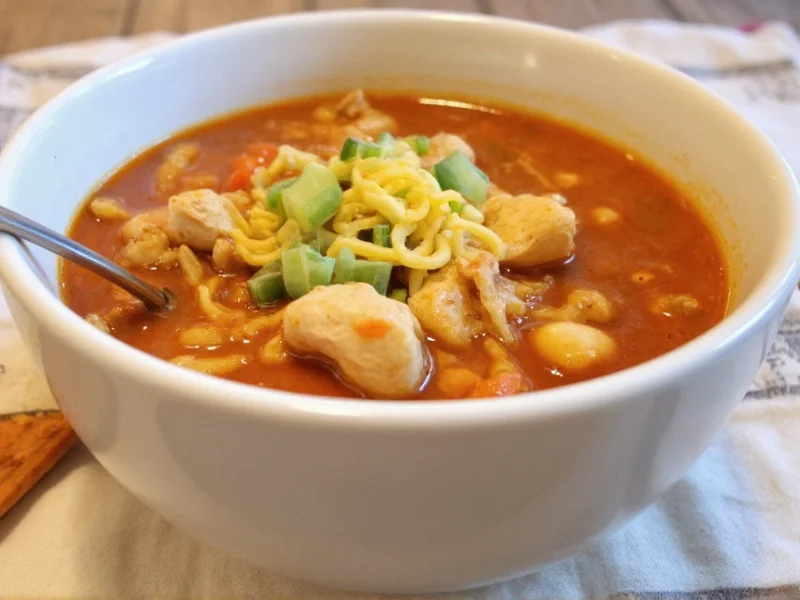Understanding the exact calorie content of chicken tortilla soup is essential for anyone tracking their nutritional intake. This popular Mexican-inspired soup offers a satisfying blend of protein, vegetables, and carbohydrates, but its caloric value can range dramatically depending on how it's prepared.
Factors That Impact Chicken Tortilla Soup Calories
Several key elements determine the final calorie count in your bowl:
- Fat content of chicken - Using skinless breast versus thigh meat affects calories significantly
- Oil quantity - The amount used for sautéing vegetables and toasting spices
- Beans and corn - These healthy additions increase both calories and fiber content
- Toppings - Avocado, cheese, sour cream, and fried tortilla strips dramatically boost calories
- Broth concentration - Thicker, reduced broths contain more calories per serving
Calorie Comparison: Homemade vs. Restaurant vs. Canned
| Type | Portion Size | Calories | Key Variables |
|---|---|---|---|
| Homemade (basic recipe) | 1 cup (240ml) | 150-250 | Lean chicken, minimal oil, light toppings |
| Restaurant serving | 16-24 oz bowl | 300-500+ | Larger portions, added fats, generous toppings |
| Canned (store-bought) | 1 cup (240ml) | 100-200 | Reduced-fat versions available, check labels |
| Low-calorie version | 1 cup (240ml) | 100-140 | Extra vegetables, no cheese/sour cream, minimal oil |
Detailed Calorie Breakdown by Popular Restaurant Chains
When ordering chicken tortilla soup at restaurants, portion sizes often exceed standard servings. Here's what you might encounter:
- Chipotle - Their chicken tortilla soup (16 oz serving) contains approximately 340 calories. The recipe features chicken, black beans, corn, and tomatoes in a flavorful broth.
- Taco Bell - A standard serving (13.7 oz) has about 170 calories, making it one of the lower-calorie fast food options.
- Chili's - Their version (16 oz bowl) ranges from 350-450 calories depending on added toppings.
- Local Mexican restaurants - Often serve larger portions (24+ oz) that can reach 500+ calories with traditional preparation methods.
Nutritional Profile Beyond Calories
While tracking chicken tortilla soup calories per serving is important, examining the complete nutritional profile provides better context for dietary planning. A standard homemade serving typically contains:
- Protein: 15-20g - primarily from chicken and beans
- Carbohydrates: 20-30g - from vegetables, corn, and sometimes rice
- Fat: 3-8g - mostly unsaturated from olive oil and avocado (if added)
- Fiber: 5-8g - excellent source from beans and vegetables
- Sodium: 400-800mg - varies significantly by recipe
This balanced macronutrient profile makes chicken tortilla soup a nutritionally sound meal option when prepared with attention to ingredients. The high fiber content promotes satiety, potentially helping with weight management despite moderate calorie counts.
Creating Lower-Calorie Chicken Tortilla Soup
If you're monitoring your intake of chicken tortilla soup nutrition facts, consider these practical modifications:
- Use skinless chicken breast instead of thigh meat
- Reduce oil to 1 teaspoon for sautéing
- Increase vegetable content (zucchini, bell peppers, mushrooms)
- Limit beans to ½ cup per serving
- Use low-sodium vegetable broth
- Top with fresh cilantro and lime instead of cheese and sour cream
- Make your own baked tortilla strips using whole wheat tortillas
These adjustments can reduce a standard serving from 250 calories to approximately 120-140 calories while maintaining flavor and nutritional value. Many home cooks find that building flavor with spices like cumin, chili powder, and smoked paprika compensates for reduced fats.
Reading Canned Soup Labels Effectively
When selecting store-bought chicken tortilla soup calories become easier to track with proper label reading. Pay attention to:
- Serving size - Many cans list multiple servings per container
- Total calories per serving - Not just per 100g
- Fat content - Look for options under 3g fat per serving
- Sodium levels - Choose varieties under 480mg per serving
- Added sugars - Some brands include unexpected sweeteners
Low-sodium and reduced-fat versions of canned chicken tortilla soup often provide the most accurate chicken tortilla soup calories per cup for calorie-conscious consumers. Always check the nutrition facts panel rather than relying on front-of-package claims.
Portion Control for Restaurant Orders
Restaurant portions of chicken tortilla soup frequently exceed recommended serving sizes. To manage your intake:
- Ask for a to-go container immediately and portion half before eating
- Request toppings on the side to control added calories
- Choose broth-based versions over creamy preparations
- Share a bowl with a dining companion
- Consider the soup as an appetizer rather than a main course
These strategies help maintain awareness of actual chicken tortilla soup calories consumed when dining out, where portion distortion is common.
Tracking Accuracy for Homemade Versions
For those preparing chicken tortilla soup at home, precise calorie calculation requires:
- Weighing ingredients rather than estimating
- Using a reliable nutrition database for custom recipes
- Accounting for all components including oils and toppings
- Dividing total recipe calories by actual servings made
- Adjusting for evaporation during cooking (concentrates calories)
Many home cooks underestimate chicken tortilla soup calories per serving by 20-30% due to unaccounted oils and larger-than-expected portions. Using kitchen scales and recipe tracking apps improves accuracy significantly.











 浙公网安备
33010002000092号
浙公网安备
33010002000092号 浙B2-20120091-4
浙B2-20120091-4